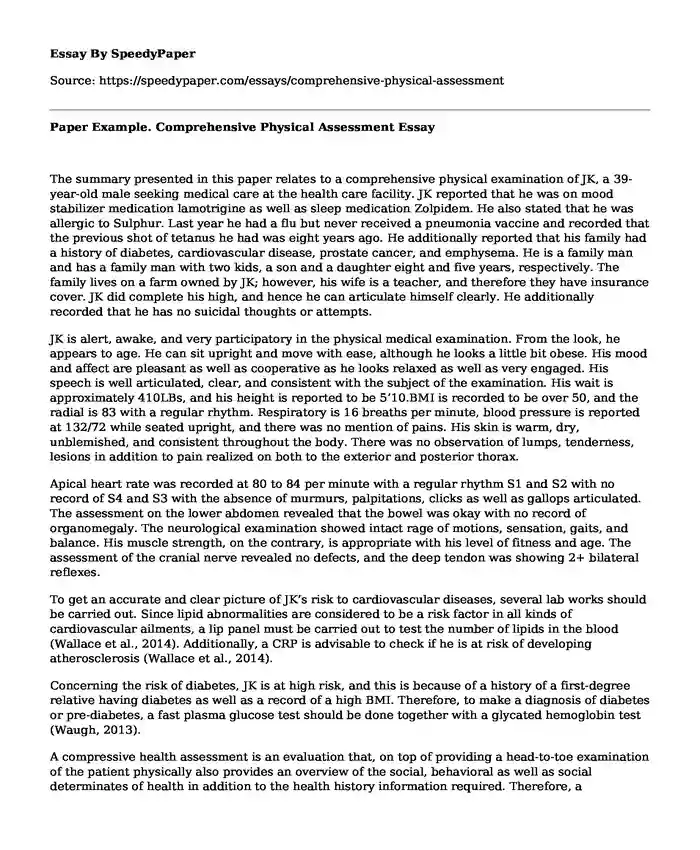
| Essay type: | Evaluation essays |
| Categories: | Medicine Healthcare |
| Pages: | 3 |
| Wordcount: | 803 words |
The summary presented in this paper relates to a comprehensive physical examination of JK, a 39-year-old male seeking medical care at the health care facility. JK reported that he was on mood stabilizer medication lamotrigine as well as sleep medication Zolpidem. He also stated that he was allergic to Sulphur. Last year he had a flu but never received a pneumonia vaccine and recorded that the previous shot of tetanus he had was eight years ago. He additionally reported that his family had a history of diabetes, cardiovascular disease, prostate cancer, and emphysema. He is a family man and has a family man with two kids, a son and a daughter eight and five years, respectively. The family lives on a farm owned by JK; however, his wife is a teacher, and therefore they have insurance cover. JK did complete his high, and hence he can articulate himself clearly. He additionally recorded that he has no suicidal thoughts or attempts.
JK is alert, awake, and very participatory in the physical medical examination. From the look, he appears to age. He can sit upright and move with ease, although he looks a little bit obese. His mood and affect are pleasant as well as cooperative as he looks relaxed as well as very engaged. His speech is well articulated, clear, and consistent with the subject of the examination. His wait is approximately 410LBs, and his height is reported to be 5’10.BMI is recorded to be over 50, and the radial is 83 with a regular rhythm. Respiratory is 16 breaths per minute, blood pressure is reported at 132/72 while seated upright, and there was no mention of pains. His skin is warm, dry, unblemished, and consistent throughout the body. There was no observation of lumps, tenderness, lesions in addition to pain realized on both to the exterior and posterior thorax.
Apical heart rate was recorded at 80 to 84 per minute with a regular rhythm S1 and S2 with no record of S4 and S3 with the absence of murmurs, palpitations, clicks as well as gallops articulated. The assessment on the lower abdomen revealed that the bowel was okay with no record of organomegaly. The neurological examination showed intact rage of motions, sensation, gaits, and balance. His muscle strength, on the contrary, is appropriate with his level of fitness and age. The assessment of the cranial nerve revealed no defects, and the deep tendon was showing 2+ bilateral reflexes.
To get an accurate and clear picture of JK’s risk to cardiovascular diseases, several lab works should be carried out. Since lipid abnormalities are considered to be a risk factor in all kinds of cardiovascular ailments, a lip panel must be carried out to test the number of lipids in the blood (Wallace et al., 2014). Additionally, a CRP is advisable to check if he is at risk of developing atherosclerosis (Wallace et al., 2014).
Concerning the risk of diabetes, JK is at high risk, and this is because of a history of a first-degree relative having diabetes as well as a record of a high BMI. Therefore, to make a diagnosis of diabetes or pre-diabetes, a fast plasma glucose test should be done together with a glycated hemoglobin test (Waugh, 2013).
A compressive health assessment is an evaluation that, on top of providing a head-to-toe examination of the patient physically also provides an overview of the social, behavioral as well as social determinates of health in addition to the health history information required. Therefore, a comprehensive physical examination ought to address the patient’s family and homestead structure (Jarvis, 2018). If the patient has a support system them it should be evaluated as well; the environment and the patient’s living area should be taken into consideration in addition to all the concerns that the family might have. The assessment present above addressed both the subjective and the objective data from the patient, which comprise the medical history, information from the physical examination, and all the health concerns. Therefore, the physical assessment focuses on the patient’s physical status, and the data is collected from what is articulated, observed, or percussed. Consequently, it is essential to note that the comprehensive physical assessment is incorporated in the holistic health assessment through a head-to-toe examination or as well used in the focused evaluation in case of any complaints (Jarvis, 2015). The objective information derived from the physical exam is further utilized in making a diagnostic.
References
Jarvis, C. (2015). Physical examination and health assessment (7th ed.). St. Louis, MO: Elsevier.
Jarvis, C. (2018). Physical Examination and Health Assessment-Canadian E-Book. Elsevier Health Sciences.
Wallace, M., Ricco, J., & Barrett, B. (2014, June). Screening strategies for cardiovascular disease in asymptomatic adults. Retrieved August 07, 2020, from https://www.ncbi.nlm.nih.gov/pmc/articles/PMC4042912/
Waugh, N. (2013). Screening strategies and tests. Retrieved August 07, 2020, from https://www.ncbi.nlm.nih.gov/books/NBK260929/
Cite this page
Paper Example. Comprehensive Physical Assessment. (2023, Oct 30). Retrieved from https://speedypaper.com/essays/comprehensive-physical-assessment
Request Removal
If you are the original author of this essay and no longer wish to have it published on the SpeedyPaper website, please click below to request its removal:
- What was the nature of the split between the Helpers and the Emigrants after the Prophet's death?
- Should Animals Be Used for Medical Research? Essay Sample
- Paper Example: Impact Of Education On Nursing And Its Future
- Essay Sample on Analysis of Social Problem: Drug Abuse
- Free Essay Sample - Zero Harm
- Women's Pregnancy, Childbirth & Puerperium: Quality Care for Optimal Wellbeing - Essay Sample
- Healthy School Meals Improve Educational Outcomes: Evidence from Belot & James (2011) - Case Study
Popular categories




